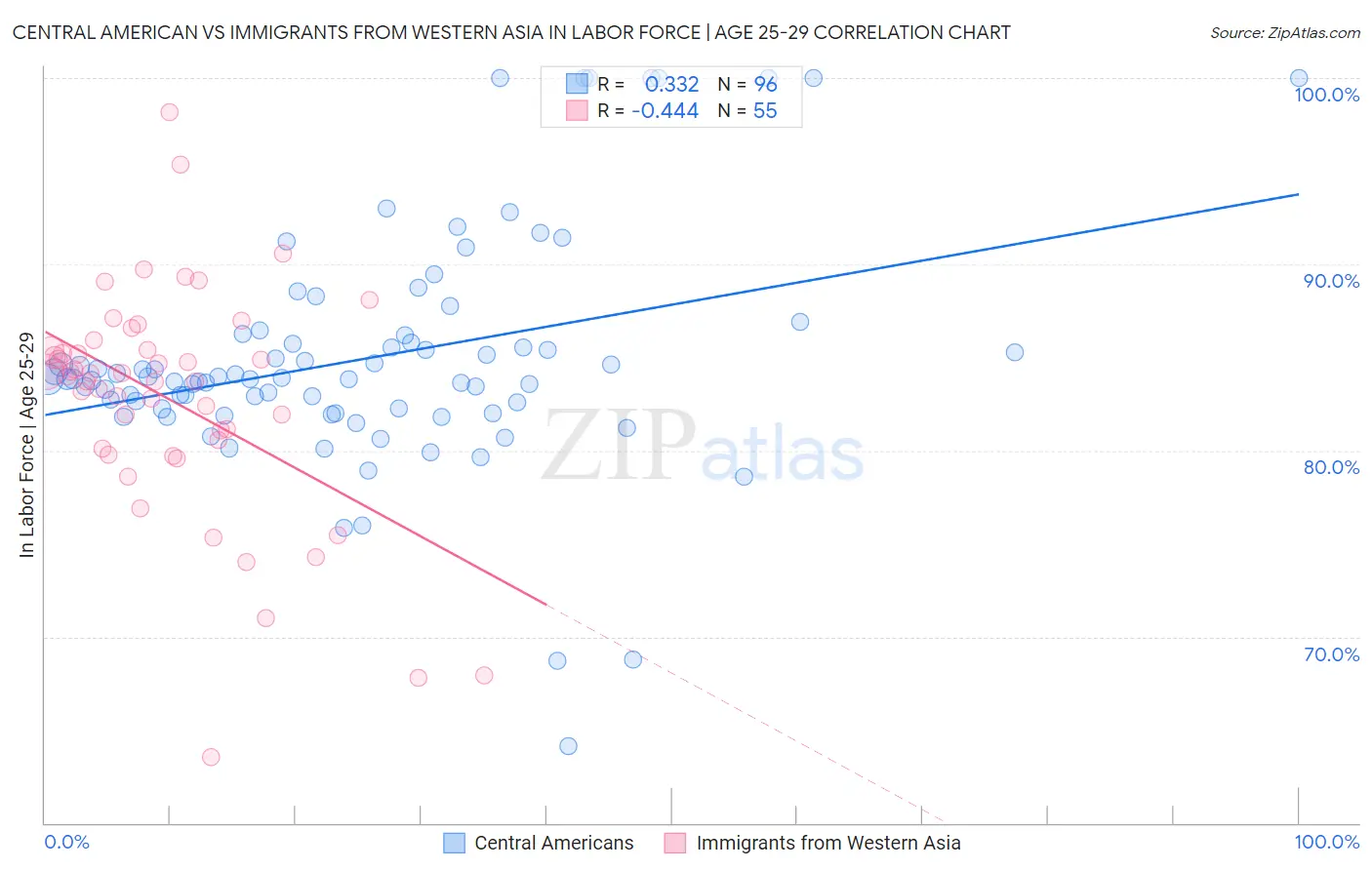Central American vs Immigrants from Western Asia In Labor Force | Age 25-29
COMPARE
Central American
Immigrants from Western Asia
In Labor Force | Age 25-29
In Labor Force | Age 25-29 Comparison
Central Americans
Immigrants from Western Asia
83.7%
IN LABOR FORCE | AGE 25-29
0.2/ 100
METRIC RATING
250th/ 347
METRIC RANK
84.1%
IN LABOR FORCE | AGE 25-29
2.7/ 100
METRIC RATING
233rd/ 347
METRIC RANK
Central American vs Immigrants from Western Asia In Labor Force | Age 25-29 Correlation Chart
The statistical analysis conducted on geographies consisting of 504,238,703 people shows a mild positive correlation between the proportion of Central Americans and labor force participation rate among population between the ages 25 and 29 in the United States with a correlation coefficient (R) of 0.332 and weighted average of 83.7%. Similarly, the statistical analysis conducted on geographies consisting of 404,303,422 people shows a moderate negative correlation between the proportion of Immigrants from Western Asia and labor force participation rate among population between the ages 25 and 29 in the United States with a correlation coefficient (R) of -0.444 and weighted average of 84.1%, a difference of 0.46%.

In Labor Force | Age 25-29 Correlation Summary
| Measurement | Central American | Immigrants from Western Asia |
| Minimum | 64.1% | 63.5% |
| Maximum | 100.0% | 98.1% |
| Range | 35.9% | 34.6% |
| Mean | 84.9% | 82.7% |
| Median | 83.8% | 84.0% |
| Interquartile 25% (IQ1) | 82.2% | 80.1% |
| Interquartile 75% (IQ3) | 86.0% | 85.4% |
| Interquartile Range (IQR) | 3.7% | 5.3% |
| Standard Deviation (Sample) | 6.3% | 6.2% |
| Standard Deviation (Population) | 6.3% | 6.2% |
Demographics Similar to Central Americans and Immigrants from Western Asia by In Labor Force | Age 25-29
In terms of in labor force | age 25-29, the demographic groups most similar to Central Americans are Hmong (83.7%, a difference of 0.020%), Bahamian (83.7%, a difference of 0.020%), Nonimmigrants (83.7%, a difference of 0.030%), Immigrants from El Salvador (83.7%, a difference of 0.040%), and Cree (83.8%, a difference of 0.060%). Similarly, the demographic groups most similar to Immigrants from Western Asia are Panamanian (84.2%, a difference of 0.10%), Immigrants from Philippines (84.2%, a difference of 0.11%), Barbadian (83.9%, a difference of 0.18%), Iraqi (83.9%, a difference of 0.20%), and Guamanian/Chamorro (83.9%, a difference of 0.20%).
| Demographics | Rating | Rank | In Labor Force | Age 25-29 |
| Immigrants | Philippines | 4.7 /100 | #231 | Tragic 84.2% |
| Panamanians | 4.5 /100 | #232 | Tragic 84.2% |
| Immigrants | Western Asia | 2.7 /100 | #233 | Tragic 84.1% |
| Barbadians | 1.0 /100 | #234 | Tragic 83.9% |
| Iraqis | 0.9 /100 | #235 | Tragic 83.9% |
| Guamanians/Chamorros | 0.9 /100 | #236 | Tragic 83.9% |
| Immigrants | Immigrants | 0.9 /100 | #237 | Tragic 83.9% |
| Immigrants | Uzbekistan | 0.8 /100 | #238 | Tragic 83.9% |
| Jamaicans | 0.8 /100 | #239 | Tragic 83.9% |
| Trinidadians and Tobagonians | 0.7 /100 | #240 | Tragic 83.9% |
| Alsatians | 0.7 /100 | #241 | Tragic 83.9% |
| U.S. Virgin Islanders | 0.6 /100 | #242 | Tragic 83.8% |
| Salvadorans | 0.5 /100 | #243 | Tragic 83.8% |
| Immigrants | Jamaica | 0.4 /100 | #244 | Tragic 83.8% |
| Iroquois | 0.4 /100 | #245 | Tragic 83.8% |
| Cree | 0.3 /100 | #246 | Tragic 83.8% |
| Immigrants | El Salvador | 0.3 /100 | #247 | Tragic 83.7% |
| Immigrants | Nonimmigrants | 0.3 /100 | #248 | Tragic 83.7% |
| Hmong | 0.3 /100 | #249 | Tragic 83.7% |
| Central Americans | 0.2 /100 | #250 | Tragic 83.7% |
| Bahamians | 0.2 /100 | #251 | Tragic 83.7% |